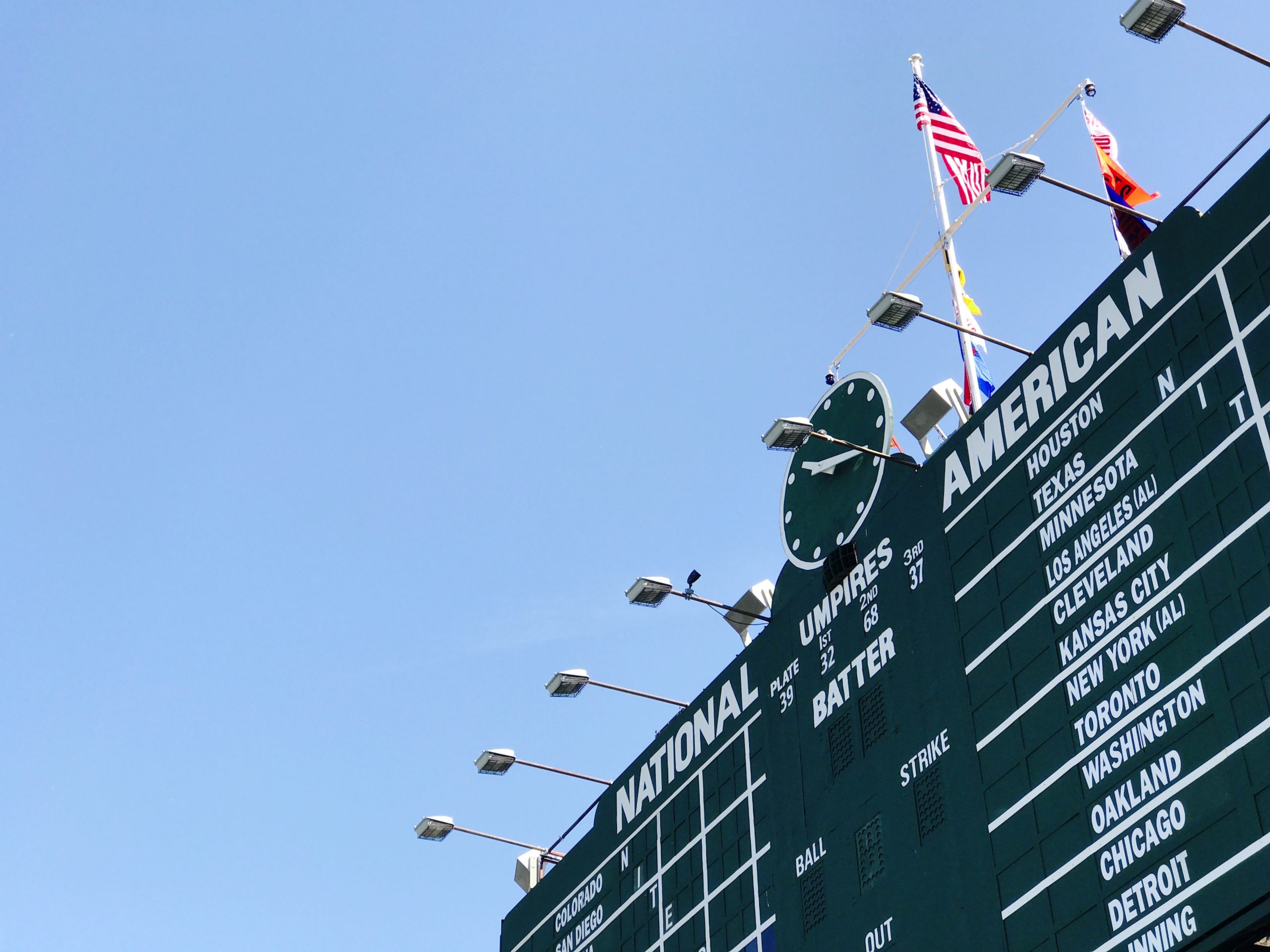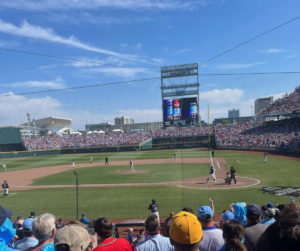If you don’t watch a ton of baseball, you may be left confused when you see a game that ends immediately before all of the innings are played.
While having a game end before 9 innings rarely happens in a major league baseball game, if you attend youth sports baseball games or high school baseball games, you will likely see games end early because of the mercy rule.
So, what exactly is the mercy rule in baseball?
The mercy rule in baseball is when a game ends early because one team is up by more than ten runs after a certain amount of innings.
In youth sports and high school baseball, the talent level can vary significantly compared to major league baseball.
As a result, rules are put in place to prevent one team from putting up an unlimited number of runs on the losing team.
| Rule | Description |
|---|---|
| Mercy Rule | The mercy rule, also known as the “run rule,” is a rule that can be invoked in certain baseball games to end the game early if one team is winning by a large margin. |
| High School | In high school baseball, the mercy rule is typically invoked if one team is winning by 10 or more runs after five innings. |
| College | In college baseball, the mercy rule is typically invoked if one team is winning by 10 or more runs after seven innings. |
| Little League | In Little League baseball, the mercy rule is typically invoked if one team is winning by 10 or more runs after four innings. |
| Professional | In professional baseball, there is no official mercy rule. However, if a game is called due to weather or other circumstances before it has become an official game (usually after five innings), the score reverts back to the last completed inning. |
| Controversy | The mercy rule can be controversial, as some people feel that it takes away from the spirit of the game and can be demoralizing for the losing team. Others argue that it is necessary to prevent blowout games from dragging on and potentially causing injuries or other issues. |
Contents
What are some other names for the Mercy Rule?
Here are some other commonly used terms for the mercy rule in youth, high school, and college baseball:
10 Run Rule
The 10-run rule is another name that is used frequently instead of the mercy rule in some baseball leagues to prevent baseball games from getting out of hand.
The 10-run rule is the most popular name used for the mercy rule throughout the different amateur levels.
People will often use short abbreviations to describe the 10 run rule such as “we 10 runned them”, or “run-ruled them.”
15 Run Rule
In 2018, Little league baseball implemented a 15-run rule option that local leagues can choose from.
At the little league level, pitchers are still learning how to throw strikes so you may have some innings where one team puts up ten runs.
This doesn’t necessarily mean that the other team is out of the game.
Choosing to go with the 15-run rule, gives teams the ability to come back and try to win the game in the event they give up a ton of runs in the inning before and is a great idea for Little League games.
How many innings is the Mercy Rule at Each level of baseball?
Let’s take a look at the how the mercy rule applies to each of the different baseball league games:
MLB Baseball
There is no mercy rule in Major League Baseball, but the topic of instituting a mercy rule has come up recently in news headlines.
You may have noticed in recent years that you see more position players pitching late in games where the score has become lopsided.
In games where one team is ahead by more than 10 runes in the 7th inning or later, teams want to not burn a relief pitching arm that they may use for the next day.
When position players pitch in a major league game, the games can drag on much longer than a typical game since some of these position players haven’t pitched in a game since high school.
As MLB looks for ways to speed up the games, the mercy rule is one idea that may be considered in future years to help end a game early that is a blowout.
Minor League Baseball
As far as we can see there is no mercy rule in Minor League baseball. Minor league baseball games are often the first place major league baseball tries out new rule changes as a testing ground before implementing them in the major leagues.
There have been some significant changes in the last couple of years designed to help speed up the game like speeding up the inning breaks, a 20-second pitch timer, and limited pitching changes.
A combined perfect game for Puerto Rico, the first in World Baseball Classic history.
And they WALKED IT OFF to win via mercy rule 🇵🇷pic.twitter.com/QeaQEi0U02
— Yahoo Sports (@YahooSports) March 14, 2023
These rules are now implemented at the Major League level for the 2023 season.
College Baseball
College Baseball has a much more loose interpretation of the mercy rule compared to professional baseball.
In College Baseball there are several different divisions of play such as:
- Division 1 Baseball
- Division 2 Baseball
- Division 3 Baseball
- NAIA Baseball
The general rule for the mercy rule in college baseball is that when one team is ahead by 10 or more runs after 6.5 or 7 innings, the game is called early.
For seven-inning games, the mercy rule would go into effect after the 5th inning.
However, the mercy rule in college baseball is implemented differently from division to division and conference to conference.
For instance, some conferences will only implement the mercy rule on Sundays on the final game of a series to give the opposing team time to get on the road and back to their campus.
The smaller the school, the more likely the mercy rule will be enforced since most of these schools travel to games by bus compared to airplane travel by most of the larger state schools.
High School Baseball
High school baseball is where you will see the most mercy rule game endings. In high school, the talent varies greatly from school to school and if games get out of hand, the mercy rule prevents the winning team from scoring endless runs vs the visiting team.
Like college baseball, high school baseball mercy rules vary from state to state and league to league.
At the highest level of high school baseball, you will see some very competitive baseball with many players that will go on to play in college.
With smaller schools, the talent can range significantly from team to team and you will see mercy run rules more frequently at the smaller high school level.
Softball
Softball is very similar to youth baseball where mercy rules are commonly used.
Because there are so many different leagues and organizations, the rule varies depending on where you play. In NCAA softball, there is an 8-run rule, which puts an end to games if one team is ahead by more than 8 runs after 5 innings.
Little League Baseball
Little league baseball has the option of the 10 or 15-run rule and leaves the decision up to the local leagues.
Things like how big the ballpark is, how competitive the pitchers are, and the age levels of the kids are just a few of many factors little league commissioners consider when choosing to go with a 10 or or 15 run rule
Is there a Mercy Rule in other Sports?
There are variations of the mercy rule in other sports as well.
Here are a few examples:
Football
In NCAA football, a mercy rule exists and can shorten a game when agreed on mutually by both coaches and the referee.
The mercy rule doesn’t happen that often but has a few times in recent years when the fourth quarters of games were shortened to 10 minutes from 15 minutes due to extreme heat or blowouts between big-time division 1 programs against smaller schools.
Basketball
There is not a mercy rule in the NBA but there is a continuous clock rule that is occasionally used at the small college and high school levels.
States have different continuous clock point differential thresholds so there isn’t one universal rule. The intention is to prevent one team from scoring endlessly and demoralizing the other team that is already down by a significant margin in the fourth quarter.
What are some of the largest margins of victory in MLB history?
Here is a list of some of the largest final score run differentials in a Major League baseball game:
| 2007 | Rangers 30, Orioles 3 |
| 1911 | Reds 26, Rustlers 3 |
| 1936 | Yankees 25, Athletics 2 |
| 1948 | Indians 26, Browns 3 |
| 1955 | White Sox 29, Athletics 6 |
| 1923 | Indians 27, Red Sox 3 |
| 1950 | Red Sox 29, Browns 4 |
Summary
While some people think the mercy run rule teaches kids a bad example of giving up on the game early, others will say it protects their morale and confidence.
As a dad, I am a fan of the mercy rule because if there wasn’t one, the long games would last for hours on end with one team putting up endless amounts of runs resulting in super long games.
I prefer the mercy rule from a time management perspective because without it I would probably be at the park for 5 plus hours on some nights waiting for the final inning!



